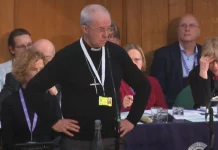The Gothic Revival sanctuary of the former Episcopal Church of the Holy Communion was a strange edifice to house a dance club, but that’s what happened in the early 1980s with the famous Limelight club in New York City.
Rocker Steve Taylor penned a snarky tribute, including this pounding chorus: “This disco used to be a cute cathedral / Where we only play the stuff you’re wanting to hear … / This disco used to be a cute cathedral / But we got no room if you ain’t gonna be chic.”
Four decades later, this song surfaced during online debates about the February 8-9 dance nights inside Canterbury Cathedral, the Church of England’s most hallowed sanctuary.
Dubbed the “rave in the nave” by critics, revelers gulped drinks from the bar and sang along to hits streamed by DJs into rented headphones. One participant described dancing to the “Horny” by Mousee T — “I’m horny, horny, horny, horny, I’m horny, horny, horny, horny tonight” — not far from the stone tiles on which St. Thomas Becket was murdered in 1170.
“The decline of Western Christendom continues unabated,” noted Taylor, via email. His song, with its reference to the Limelight, was a critique of a modernized faith willing to sacrifice its message to gain popular appeal. “I think that I referred to it as country club Christianity.”
Outside Canterbury Cathedral, one protestor told The Telegraph: “Thomas Becket is buried in the same location in this cathedral as our late Queen is buried in St George’s Chapel. Would it be acceptable to have a rave in that place? Would anyone accept that? … This is going to make people take the church less seriously than they did before, rather than more seriously.”
The cathedral’s dean rejected the “rave in the nave” label and argued that the “90s-themed silent disco” would show proper respect for the cathedral’s cultural and arts heritage.
“Cathedrals have always been part of community life in a way much wider than their prime focus as centers of Christian worship and mission,” said the Very Reverend David Monteith, in a press statement. “Whilst dancing of all different kinds has happened in the Cathedral over the centuries … there are many different views on the secular and the sacred.”
Critics are circulating a petition against entertainment events staged inside churches and cathedrals, such as a pervious mini-golf course in Rochester, a carnival helter-skelter ride in Norwich, a Star Wars festival in Peterborough and an earlier “silent disco” in Ely Abbey.
Church of England leaders admit that they are trying to raise money, while striving to appeal to worshippers — especially the young — who have shunned the pews in recent decades.
A brutal analysis published by Father David Goodhew of Middlesbrough, England, a respected voice on Anglican statistics, noted that “usual Sunday” attendance plunged from 950,000 in 2000 to 549,000 in 2022 — in a national church that claims 26 million members. With children, Sunday numbers fell 23% percent between 2019 and 2022. The Canterbury diocese had only 1,600 children in worship in 2019, which fell to 1,000 in 2022.
“Hereford ‘only’ dropped from 500 to 400 children, across all its churches, 2019-22,” wrote Goodhew, at the Covenant website. “Hereford has 399 churches. In 2023, it is likely that Hereford has more church buildings than it has children inside them, on an average Sunday across the entire diocese.”
If the Canterbury Cathedral logic is typical, then it’s hard to imagine what kind of sacred-space events loom in the future, argued Cajetan Skowronski, a physician from Sussex who leads the petition drive.
“Actually, I don’t want to give the dean any more ideas. Because based on the logic that the Cathedral needs to entertain, increase young footfall and rake in the denarii, there really is no red line which cannot be crossed,” he wrote, for the European Conservative. “He is perfectly happy to break his own laws, as the Anglican Canons of the Church of England explicitly command that churches not be ‘profaned by any meeting therein for temporal objects inconsistent with the sanctity of the place’ and any secular music played must be ‘consonant with sound doctrine, and make for the edifying of the people.'”
Skowronski then added, in the words of a ’90s Britney Spears dance hit: “Hit me baby one more time!”










